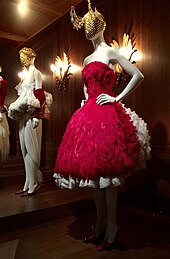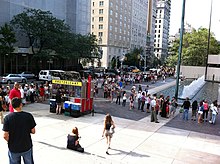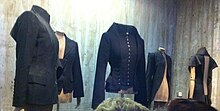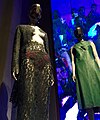Savage Beauty
Topic: Alexander McQueen
 From Wikipedia - Reading time: 13 min
From Wikipedia - Reading time: 13 min

Alexander McQueen: Savage Beauty was an art exhibition held in 2011 at the Metropolitan Museum of Art featuring clothing created by British fashion designer Alexander McQueen, as well as accessories created for his runway shows. The exhibit was extremely popular in New York City and resulted in what was then record attendance for the museum.[1] The curators were Andrew Bolton and Harold Koda.[2]
The show opened on May 4, a little more than one year after McQueen's death, and closed on August 7. Savage Beauty was shown again at the Victoria and Albert Museum in London from March 14, 2015, to August 2, 2015, but with additional items of exhibits.
Contents
[edit]
The exhibit was organized by the museum's Anna Wintour Costume Center and curated by Andrew Bolton and Harold Koda. The exhibit featured McQueen's pieces from the archives of his own London fashion house, Alexander McQueen, and of the Parisian couture house Givenchy, as well as pieces held in private collections.[3] The show composed of six separate galleries, arranged by theme: "The Romantic Mind", which featured some of his oldest work in the early 1990s; "Romantic Gothic and the Cabinet of Curiosities", which featured his exploration of Victorian Gothic themes; "Romantic Nationalism", which examined Scottish and British identity; "Romantic Exoticism", which examined non-western influences in his designs; "Romantic Primitivism", which featured natural materials and organic designs; and "Romantic Naturalism", which featured his attempts to integrate themes of the natural world with technology.[3]

The exhibit included pieces from his first major collection, Jack the Ripper Stalks His Victims, created during his graduate studies at Central Saint Martins College of Art and Design.[4] Other collections included in the exhibit were Dante, It's a Jungle out There, Irere, #13, VOSS, and Plato's Atlantis,[5] as well as Banshee, Highland Rape, The Widows of Culloden (including the original life-size hologram of Kate Moss), and Horn of Plenty.[4] Also included in the exhibition were works by McQueen's collaborators such as the milliner Philip Treacy and jeweler Shaun Leane who produced designs used in his runway shows.[6]
Reception
[edit]
The exhibit was widely praised by critics in the international press. Hilary Alexander of The Daily Telegraph called it "an absorbing, astounding walk through the extraordinary convolutions of his mind, and the technical virtuosity he could summon up in order to turn his ideas and thoughts into reality".[4] Holland Cotter of The New York Times wrote that the show "is a button-pushing marvel: ethereal and gross, graceful and utterly manipulative, and poised on a line where fashion turns into something else", but also noted that the exhibit steers clear of addressing questions about the contradictions in his work.[7] Suzy Menkes of The International Herald Tribune also had some issues with the presentation, "Mr. Bolton might have discussed the designer's place in the British art scene, alongside the Chapman brothers, or compared his fascination with nature's decadence with that of Damien Hirst. Instead, we get Sarah Jessica Parker's breathless and witless take on the McQueen style." Overall, though, she said the exhibit "is exciting, stimulating and thought-provoking – and a raw vision of the wild McQueen imagination."[8] Judith Thurman of The New Yorker advised that "even if you never bother with fashion shows, go to this one. Andrew Bolton ... has assembled a hundred ensembles and seventy accessories ... and he gives their history and psychology an astute reading."[9]

The show was also extremely popular with the public, leading the museum to take extraordinary measures to meet demand. Originally scheduled to run only until July 31 that year, it was extended through August 7. Patrons waited in lines of up to two hours to see the exhibit.[10] To accommodate the large crowds, the Met offered a special $50 ticket to view the exhibit on Mondays, when the museum was usually closed.[11][12] Over 17,000 of these tickets were sold.[13] The Met also allowed its members to skip the line; museum membership increased 15%, with 20,000 new memberships sold during the show.[13] During the final weekend of the exhibition, lines stretched to over four hours,[14] and the museum stayed open until midnight for the first time in its history.[10] By the time the exhibit closed, over 650,000 people had seen it,[15] making it one of the most popular exhibits in the museum's history, and its most popular fashion exhibit ever.[16]
Subsequent showings
[edit]
From March 14, 2015, to August 2, 2015, the exhibition was housed in the Victoria and Albert Museum in London, where it was similarly well-received.[17][18][19] The core of the exhibition remained the same as the one in the Metropolitan Museum, but 66 additional items of clothing and accessories were added, including rarely seen early works by McQueen. A new section was added focusing on pieces from his early career. The exhibition was the largest collection of works by McQueen and his collaborators ever assembled.[20] Ticket sales exceeding 480,000 prompted museum management to implement overnight hours during the show's final two weekends in order to meet demand.[21] This was the first time the museum had ever extended its hours this way to accommodate interest in an exhibition.[22]
Gallery
[edit]McQueen's fascination with the elemental—earth, wind, fire and water—imbued his collections with primordial drama. Nature and its materials were a constant in McQueen's work.[23] Each piece was made from unique materials, which suits each item. McQueen did not use any leather; he used recycled and natural materials to substitute the collection as up-cycled. For example, some materials he usually used in his work included hair, wood, taxidermy, horns, and coral. In addition, he also referenced reptile skin and blood onto his work. Cotton used in McQueen's pieces to represent a natural product because of the way it is designed.[clarification needed]
-
Jack the Ripper Stalks His Victims, MA graduation collection
-
Black suit Spring/Summer 1997
-
The Birds, Spring/Summer 1995
-
Highland Rape, Autumn/Winter 1995–96
-
Givenchy Autumn/Winter 1997–98
-
No. 13, Spring/Summer 1999
-
Eshu, Autumn/Winter 2000–01
-
Parachute Cape, Supercalifragilisticexpialidocious, Autumn/Winter 2002–03
-
The Horn of Plenty, Autumn/Winter 2009–10
-
One of McQueen's last works
References
[edit]- ^ Orden, Erica (July 22, 2011). "Met Hits 40-Year Attendance Record". The Wall Street Journal. Archived from the original on July 20, 2018. Retrieved August 6, 2011.
- ^ Trebay, Guy (April 29, 2015). "At the Met, Andrew Bolton Is the Storyteller in Chief". New York Times. Archived from the original on October 2, 2015. Retrieved August 13, 2015.
- ^ a b "About the Exhibition". Metropolitan Museum of Art. Archived from the original on August 12, 2011. Retrieved August 5, 2011.
- ^ a b c Alexander, Hilary (May 2, 2011). "Alexander McQueen's 'Savage Beauty' honoured in style". The Telegraph. Archived from the original on April 1, 2017. Retrieved August 6, 2011.
- ^ "Alexander McQueen: Savage Beauty at The Costume Institute of The Metropolitan Museum of Art N.Y.C". AlexanderMcQueen.com. Archived from the original on November 5, 2011. Retrieved August 6, 2011.
- ^ "McQueen: Savage Beauty". Nowness. May 3, 2011. Archived from the original on September 26, 2021. Retrieved April 8, 2021.
- ^ Cotter, Holland (May 4, 2011). "Designer as Dramatist, and the Tales He Left Behind". The New York Times. Archived from the original on July 20, 2018. Retrieved August 6, 2011.
- ^ Menkes, Suzy (May 2, 2011). "Alexander McQueen in All His Dark Glory". The International Herald Tribune. Archived from the original on May 12, 2013. Retrieved August 6, 2011.
- ^ Thurman, Judith (May 16, 2011). "Dressed to Thrill". The New Yorker. Archived from the original on June 6, 2014. Retrieved August 6, 2011.
- ^ a b Vogel, Carol (July 27, 2011). "Met Museum to Stay Open for McQueen Show Later Than Ever Before". The New York Times. Archived from the original on August 11, 2011. Retrieved August 6, 2011.
- ^ Kennedy, Randy (May 31, 2011). "Met Museum to Add Hours, Charge $50 to Accommodate McQueen Show Crowds". The New York Times. Archived from the original on August 6, 2011. Retrieved August 6, 2011.
- ^ Vogel, Carol (July 11, 2011). "Met's McQueen Show Adds Yet More Hours". The New York Times. Archived from the original on August 24, 2011. Retrieved August 6, 2011.
- ^ a b Swanson, Abbie Fentress (August 5, 2011). "Hundreds Line Up to See Alexander McQueen Show Before it Closes". WNYC.com. Archived from the original on August 10, 2011. Retrieved August 6, 2011.
- ^ Hollander, Sophia (August 6, 2011). "Not Since the 'Mona Lisa'..." The Wall Street Journal. Archived from the original on July 20, 2018. Retrieved August 6, 2011.
- ^ Beja, Marc (August 7, 2011). "Thousands show up for last day of Met's McQueen exhibit". Archived from the original on March 23, 2012. Retrieved August 8, 2011.
- ^ "McQueen show shuts in NY after record attendance". AFP. August 6, 2011. Archived from the original on January 24, 2013. Retrieved August 7, 2011.
- ^ "Ikon London Magazine coverage of Alexander McQueen: Savage Beauty Fashion Gala". Ikon London Magazine. March 14, 2015. Archived from the original on July 20, 2018. Retrieved March 3, 2018.
- ^ "Alexander McQueen: Savage Beauty - About the Exhibition". V&A. Archived from the original on July 20, 2018. Retrieved March 10, 2015.
- ^ Dowd, Vincent (March 10, 2015). "Alexander McQueen: Revolutionary and friend". BBC News. Archived from the original on August 20, 2018. Retrieved March 10, 2015.
- ^ "Alexander McQueen: Savage Beauty" (PDF). V&A. Archived (PDF) from the original on October 9, 2024. Retrieved March 16, 2021.
- ^ "Alexander McQueen: Savage Beauty is most popular show in V&A's history". The Guardian. August 3, 2015. Archived from the original on December 26, 2017. Retrieved October 29, 2015.
- ^ "Alexander McQueen: Savage Beauty is most popular show in V&A's history". The Guardian. August 3, 2015. Archived from the original on December 26, 2017. Retrieved October 29, 2015.
- ^ Stępień, Justyna (2021), "'Savage Beauties'", Staging Fashion, Bloomsbury Visual Arts, pp. 71–82, doi:10.5040/9781350101869.0014, ISBN 9781350101869, S2CID 241192838, archived from the original on October 9, 2024, retrieved November 3, 2021
 KSF
KSF








